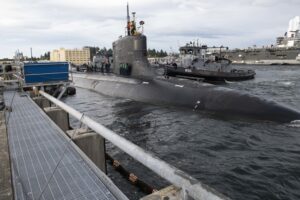The SSN(X), the Navy’s planned next-generation nuclear-powered attack submarine, will feature many torpedoes in a focus on deeper blue water naval combat roles, an official said last week.
The Navy is planning for the SSN(X) to succeed the current Virginia-class attack submarine while retaining some features from it as well as the the
Seawolf-class attack submarine and the under-construction Columbia-class ballistic missile submarine (SSBN). It is hoping the vessel will be faster and likely larger than Virginia-class while adding stealth and sensor capabilities.
“Virginia remains the most capable multi-mission submarine in the world, bar none. But we must maintain our undersea advantage by investing for future capabilities and we know we need to start that work today to ensure we can deliver SSN(X) in time of need and without lots of technical or schedule risk. So we’re working on that now,” Rear Adm. Doug Perry, director of Undersea Warfare (N97), said at the Naval Submarine League’s annual symposium on Nov. 18.
Perry said while the service does not yet know the specific characteristics that will be on SSN(X), “but we do believe that that next submarine will have a large horizontal payload capacity and you can read that as it’s going to carry a lot of torpedoes, and we know how to do that. It will be fast, and it’ll have acoustic superiority, that’s both sensors to hear the other ships out there as well as stealth – staying quiet.”
He said the Navy knows how to add acoustic superiority to attack submarines, with the Navy Acoustic Superiority Program beginning on the Virginia-class USS South Dakota (SSN-790), commissioned in 2019. The program includes a large vertical array mounted on the hull aft of the sail, a special exterior coating and machinery quieting improvements inside the vessel.

Perry said it is also important for the SSN(X) to have a high operational availability and make sure it has a good class maintenance plan.
“We’ve learned a lot from operating [Los Angeles-class attack submarines] and Seawolf and Virginia. So we…are analyzing those class maintenance plans with Program Executive Office Attack Submarines (SSN) and making sure that the class maintenance plan we come up with gets us the highest operational availability possible…and we’ve got to do all that with a reasonable cost.”
Perry underscored the Navy will use the future Virginia-class Block VI and VII vessels as further evolutions to add new capabilities and help mitigate technical risk on things they hope to add to SSN(X).
“Because we want to design them now and get them on platforms where we can…so that’s an evolutionary effort to make sure that when we get to a different submarine, SSN(X), that we are able to integrate those capabilities.”
Last year, Rear Adm. David Goggins, then PEO for Submarines but now PEO SSN, said the Virginia-class Block VI vessel will expand on the SSN-790 additions and focus on improving stealth, enhanced sonar performance like using a bow conformal array, and enhancing its ability to sense and interact with more of the water column and seafloor (Defense Daily, Nov. 20, 2020).
Perry also reiterated SSN(X) design and construction work should use workforces transitioning out of Columbia-class work at the right times to maintain efficiency.
Based on the Columbia-class construction timing, SSN(X) would ideally start just as the SSBN construction work is wrapping up in the 2040s.
“Building any new class of submarine is challenging but we’ve got to strike while the iron is hot. And here are some key takeaways here – Columbia is 95% design complete. Now is the time to begin transitioning that experienced design team, that design workforce, these are engineers…from Columbia over to the next submarine,” Perry said.
He added this timing also allows the submarine construction workforces at prime contractors Huntington Ingalls Industries [HII] and General Dynamics’ Electric Boat [GD] as well as supporting subcontractors and suppliers to maintain a steady demand signal, “which is a key element of developing and sustaining a resilient submarine industrial base.”
The Navy requested $30 million in funds to help develop the SSN(X) while it is developing an acquisition strategy and starting to consult with industry to inform the contracts and capabilities (Defense Daily, June 4).
Last year, naval reactor builder BWX Technologies [BWXT] CEO and President Rex Geveden said the company expects SSN(X) to be significantly larger than the Virginia-class and be closer to the Columbia-class size (Defense Daily, Nov. 4, 2020).
In July, Rear Adm. Bill Houston, Director of the Undersea Warfare Division, N97, said the Navy is seeking to make SSN(X) “the ultimate apex predator” by combining the speed and payload of the Seawolf-class with the Virginia-class acoustics and sensors as well as the Columbia-class operational availability and life of the ship (Defense Daily, July 23).
Houston said the submarine will need to go behind enemy lines and deliver a punch to establish U.S. naval primacy.
In 2018, a Congressional Budget Office (CBO) report warned the SSN(X) could cost about $5.5 billion per submarine, significantly higher than the Navy’s estimate of $3.1 billion per vessel. The CBO assumed it would be closer to a Seawolf-sized vessel than Virginia-class (Defense Daily, Oct. 19, 2018).